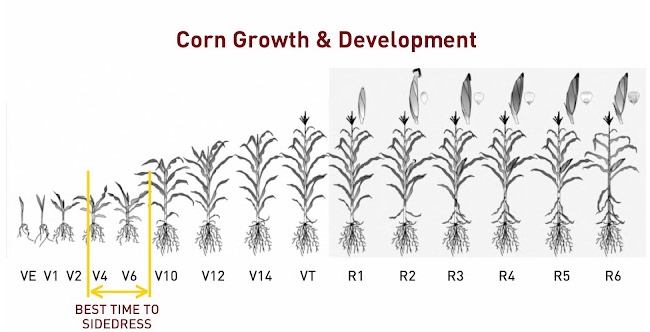2. How much of your N should be applied as sidedress, and when during the growing season should you apply?
Several research projects funded by Minnesota’s fertilizer tonnage fee and commodity checkoff programs have consistently shown that lighter-textured soils benefit from a higher proportion of N applied as sidedress. This is due to the increased risk of N loss from a spring pre-plant application. In finer textured soils, a timely split application may or may not be worth the cost every year, depending on the potential for N loss. In excessively wet years or areas in the field where soils tend to stay wet after rainfall, split applications have a better chance to improve yields.
If you want to split-apply nitrogen in corn-on-corn situations, you should apply a higher rate as pre-plant because high residue levels can temporarily immobilize N and lead to deficiency symptoms early in the growing season. Corn-following-soybean fields can have a higher percentage of total N applied as sidedress, which can be a real time saver when spring fieldwork conditions are challenging and limited working days place a higher priority on getting the crop planted.
University of Minnesota research has shown that 40 pounds of N per acre pre-plant is usually enough to get the crop started until an in-season application, as long as you sidedress no later than V8 to V9. The V4 to V8 stage seems to be the best time to sidedress nitrogen in Minnesota. In our experience, in-season applications after the V10 stage have never produced higher yields, and sometimes have actually reduced yields compared to earlier applications.

If you apply a higher percentage of your N as sidedress, you need to take steps to ensure even application to avoid crop deficiencies in small pockets throughout the field.
If topdressing with urea, avoid windy days that can cause the spread pattern to be inconsistent. If using drop nozzles that run along the ground, make sure they have consistent output from hose to hose and that they don’t unnecessarily “wander” or bounce around while applying.
3. Do you need to use a urease inhibitor?
Topdress-applied urea requires rainfall (or irrigation) amounting to at least a quarter inch within four days after application to prevent N loss by volatilization. Heavy dew or light rainfall that dissolves the urea granules and spreads them out without moving the urea into the soil may actually increase the risk of volatilization loss. Incorporating the fertilizer into the soil deeper than one inch with a cultivator will prevent this problem. Using a urease inhibitor can buy you additional time, up to 10 days or so.
Remember, if you are using UAN, it is half urea, so it is also subject to volatilization loss. Research in south-central Minnesota has shown small yield increases with the use of a urease inhibitor in a surface application of dribble-banded UAN.
Source : umn.edu